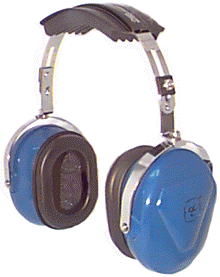
 to require hearing protection are operation
of heavy earth-moving and construction
to require hearing protection are operation
of heavy earth-moving and construction ![]() a means of attenuating noise to below damaging levels
when and where it is not possible to reduce them through engineering. Ear covers
(also known as earmuffs or headsets) and insert-type earplugs (formable, premolded, or
custom molded, and of many different shapes and compositions) are the hearing protection
devices which exist. All staff exposed to noise requiring hearing protection must
also participate in the Universities Hearing Protection program. Contact REM at
46113.
a means of attenuating noise to below damaging levels
when and where it is not possible to reduce them through engineering. Ear covers
(also known as earmuffs or headsets) and insert-type earplugs (formable, premolded, or
custom molded, and of many different shapes and compositions) are the hearing protection
devices which exist. All staff exposed to noise requiring hearing protection must
also participate in the Universities Hearing Protection program. Contact REM at
46113.
![]()
![]() Earplugs: Always read the
instructions supplied with the earplugs. Some earplugs – for example the
compressible foam type – come in only one size. If the plugs are made in several
sizes, you need the right size for each ear. To insert plugs:
Earplugs: Always read the
instructions supplied with the earplugs. Some earplugs – for example the
compressible foam type – come in only one size. If the plugs are made in several
sizes, you need the right size for each ear. To insert plugs:
- Reach around your head and take hold of the back of your ear about half way down
- Gently pull your ear outwards and upwards to straighten your ear canal
- Insert the plug into your ear canal with the other hand.
- Roll the plug slowly and smoothly into a thin crease-free cylinder (depending on how small you roll the plug, it can take up to 30 seconds to do this, possibly longer if you haven’t done it before)
- Immediately insert the plug well into the ear canal and hold it in place until it has begun to expand and block the noise. Aim to get three-quarters of the length of the plug into the canal.
Earmuffs: Inspect the muffs and note which way they are meant to be worn. Some earmuff cups are marked top or front and should be worn that way. Oval shaped cups are meant to be worn so that the oval is vertical.
- Extend the headband to its maximum length.
- Brush as much hair as possible away from the ears
- Place the muffs over the ears, making sure that the ears fit right inside the cups and are not pressed against the head
- Hold the cups firmly in place by pressing inwards and upwards with the thumbs and tighten the headband so that it takes the weight of the cups and holds them firmly in position
- Run your fingers around the cushions to check that they are making a good seal against your skin.
It takes two to three weeks to get used to wearing hearing protectors.
Once you are used to them you will, feel less stressed while you’re working, feel
less tired at the end of the day, and know your hearing is safe.